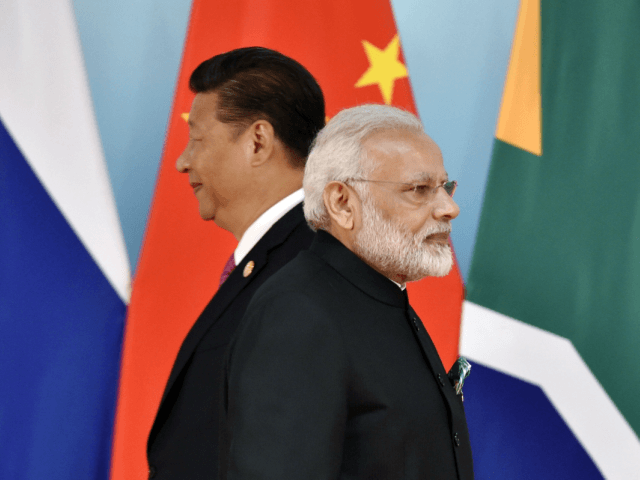A Chinese government spokesman asserted that the communist regime will “firmly safeguard territorial sovereignty” against India, responding on Monday to a top Indian general’s promise to “not allow our territory to be invaded upon” in the disputed Doklam region.
The Times of India published satellite images that indicate a growing Chinese military buildup on the nations’ mutual border. China and India recently resolved a dispute that lasted for much of 2017 over the Doklam plateau, which spans territory in China, India, and Bhutan. The Bhutanese government requested support from the much more formidable Indian army last year after Chinese troops crossed into their territory, ostensibly in the process of building road infrastructure in the area. India responded by entering what China claimed was its territory and blocking Chinese builders from continuing a road past the Chinese border.
The Indian troops ultimately retreated, but now New Delhi has sounded the alarm on evidence of a resurging Chinese presence in the area.
“The Peoples’ Liberation Army (PLA) has left behind tanks, stores, tents and other military equipment at the Doklam plateau,” the Times of India reported, supporting the claim with satellite images. “The satellite images accessed by Times Now show that the Chinese troops have only partially moved back, thus indicating a possibility of occupying the territory once again.”
Chinese Foreign Ministry Lu Kang, responding to vocal concerns from Indian military leaders, said, plainly, “The Doklam area belongs to China.”
“China will continue to exert its rights in the Doklam area and firmly safeguard territorial sovereignty,” Lu asserted. “We asked the Indian military to learn their lessons and abide by the boundary treaty in an effort to safeguard the peace and stability in the border areas and create a good atmosphere for developing bilateral ties.”
Lu made clear to reporters he was responding to comments by Indian army chief General Bipin Rawat on Friday in which he expressed concern that China’s presence in the region was growing.
“We understand China is a powerful country but we are not a weak nation,” Rawat reportedly stated. “We have increased our troop levels … we have increased our patrolling intensity. We are capable of handling China´s assertiveness.”
“We will not allow our territory to be invaded upon. Whenever intrusions take place we will defend because that´s there in our charter,” Rawat concluded. “We knew they will try and claim the whole of Doklam.”
Lu accused Rawat of going “against the consensus reached by the two heads of state,” Indian Prime Minister Narendra Modi and Chinese communist leader Xi Jinping, during discussions about Doklam in September. Rawat, he asserted, was being “unproductive.”
Before Xi and Modi met during last year’s BRICS summit, the Chinese Foreign Ministry had threatened Indian troops repeatedly, accusing India of “slapping its own face” by refusing to accept Chinese incursions into its territory and beginning to construct its own roads in the area. Modi withdrew the troops his government had deliberately sent past the Chinese border following high-level diplomatic discussions in September.
Rawat maintained that month, amid diplomatic conversations between the two countries, that India’s military needed to remain alert in the face of China’s growing colonizing of its territory to the north.
“As far as the northern adversary (China) is concerned, the flexing of muscles has started,” Rawat warned at the time. “Salami slicing, taking over territory in a very gradual manner, testing our limits of threshold … is something we have to be wary about and remain prepared for situations that could develop into conflicts.”
Two months later, reports began to surface that China had restarted its military buildup in the region. Reports in December suggested that over 1,000 Chinese troops had amassed on the border with India and that China had developed “two helicopter platforms, dozens of houses and stores, and upgraded roads to cope with the very severe winter.”

COMMENTS
Please let us know if you're having issues with commenting.